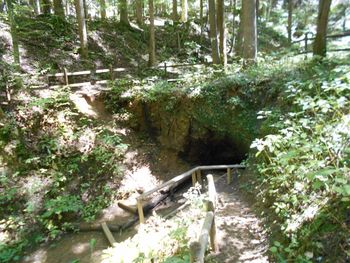From the visitor center walk between the water wheel building and the bathrooms. Head left and go under the waterwheel flume to begin the hike.
Short trail beginning at the visitor center.
Being a TN state park, the dirt and gravel trails are kept in good condition. Some of the trail sections are steep, thus can be slippery after a rain.
General John T. Wilder purchased this land as part of a 7,000 acre purchase for $25.15 an acre in 1870. One of the mines he started became known as the Peg Leg Mine. The mine was mined for iron ore. The ore was sent to a smelter across the Doe River. The water wheel, similar to the one near the visitor's center, was used to lift and drop a 500-lb hammer and to crush the ore. The ore would then be loaded on to rail cars and sent to Cranberry, North Carolina for further processing before making its way to Ohio and Pennsylvania to a steel mill.
Loading map...
{"type":"TERRAIN","minzoom":false,"maxzoom":false,"types":["ROADMAP","SATELLITE","HYBRID","TERRAIN"],"mappingservice":"googlemaps3","width":"auto","height":"550px","centre":{"text":"","title":"","link":"","lat":36.17654399999999981218934408389031887054443359375,"lon":-82.0777250000000009322320693172514438629150390625,"icon":""},"title":"","label":"","icon":"","lines":[],"polygons":[],"circles":[],"rectangles":[],"copycoords":false,"static":false,"visitedicon":"","wmsoverlay":false,"zoom":16,"layers":[],"controls":["pan","zoom","type","scale","streetview","rotate"],"zoomstyle":"DEFAULT","typestyle":"DEFAULT","autoinfowindows":false,"resizable":false,"kmlrezoom":false,"poi":true,"cluster":false,"clustergridsize":60,"clustermaxzoom":20,"clusterzoomonclick":true,"clusteraveragecenter":true,"clusterminsize":2,"imageoverlays":[],"kml":[],"gkml":["http://tehcc.org/clubwiki/kml/RMSP_Peg_Leg_Trail.kml"],"searchmarkers":"","fullscreen":false,"scrollwheelzoom":false,"locations":[{"text":"\u003Cdiv class=\"mw-parser-output\"\u003E\u003Cp\u003ETrail head\n\u003C/p\u003E\u003C/div\u003E","title":"Trail head\n","link":"","lat":36.17633000000000009777068044058978557586669921875,"lon":-82.07900200000000268119038082659244537353515625,"icon":"/clubwiki/images/MarkerG.png"},{"text":"\u003Cb\u003E\u003Cdiv class=\"mw-parser-output\"\u003E\u003Cp\u003ETrail split\n\u003C/p\u003E\u003C/div\u003E\u003C/b\u003E\u003Cdiv class=\"mw-parser-output\"\u003E\u003Cp\u003EContinue right for the trail, unknown trail to the left\n\u003C/p\u003E\u003C/div\u003E","title":"Trail split\n","link":"","lat":36.17688199999999909550751908682286739349365234375,"lon":-82.078970999999995683538145385682582855224609375,"icon":"/clubwiki/images/MarkerG.png"},{"text":"\u003Cb\u003E\u003Cdiv class=\"mw-parser-output\"\u003E\u003Cp\u003EViewing platform\n\u003C/p\u003E\u003C/div\u003E\u003C/b\u003E\u003Cdiv class=\"mw-parser-output\"\u003E\u003Cp\u003E\u003Ca href=\"/wiki/File:Roan_Peg_Leg_view_from_platform.jpg\" class=\"image\" title=\"View from the platform\"\u003E\u003Cimg alt=\"View from the platform\" src=\"/clubwiki/images/thumb/Roan_Peg_Leg_view_from_platform.jpg/150px-Roan_Peg_Leg_view_from_platform.jpg\" decoding=\"async\" width=\"150\" height=\"113\" srcset=\"/clubwiki/images/thumb/Roan_Peg_Leg_view_from_platform.jpg/225px-Roan_Peg_Leg_view_from_platform.jpg 1.5x, /clubwiki/images/thumb/Roan_Peg_Leg_view_from_platform.jpg/300px-Roan_Peg_Leg_view_from_platform.jpg 2x\" data-file-width=\"1024\" data-file-height=\"768\" /\u003E\u003C/a\u003E\n\u003C/p\u003E\u003C/div\u003E","title":"Viewing platform\n","link":"","lat":36.17671899999999851615939405746757984161376953125,"lon":-82.0776149999999944384398986585438251495361328125,"icon":"/clubwiki/images/MarkerE.png"},{"text":"\u003Cb\u003E\u003Cdiv class=\"mw-parser-output\"\u003E\u003Cp\u003EPeg leg mine\n\u003C/p\u003E\u003C/div\u003E\u003C/b\u003E\u003Cdiv class=\"mw-parser-output\"\u003E\u003Cp\u003E\u003Ca href=\"/wiki/File:Roan_Peg_Leg_mine_entrance.jpg\" class=\"image\" title=\"View of the mine\"\u003E\u003Cimg alt=\"View of the mine\" src=\"/clubwiki/images/thumb/Roan_Peg_Leg_mine_entrance.jpg/150px-Roan_Peg_Leg_mine_entrance.jpg\" decoding=\"async\" width=\"150\" height=\"113\" srcset=\"/clubwiki/images/thumb/Roan_Peg_Leg_mine_entrance.jpg/225px-Roan_Peg_Leg_mine_entrance.jpg 1.5x, /clubwiki/images/thumb/Roan_Peg_Leg_mine_entrance.jpg/300px-Roan_Peg_Leg_mine_entrance.jpg 2x\" data-file-width=\"1024\" data-file-height=\"768\" /\u003E\u003C/a\u003E\n\u003C/p\u003E\u003C/div\u003E","title":"Peg leg mine\n","link":"","lat":36.1761350000000021509549696929752826690673828125,"lon":-82.076312999999998964995029382407665252685546875,"icon":"/clubwiki/images/MarkerI.png"}]}



